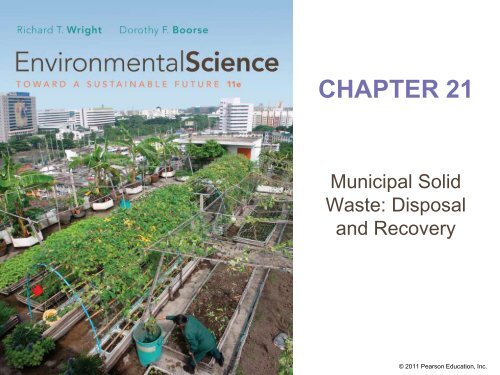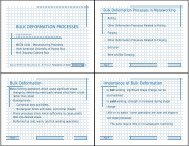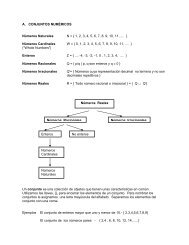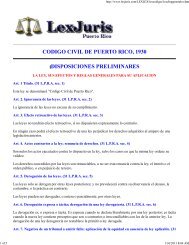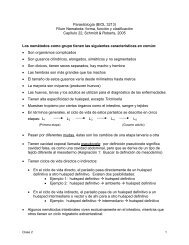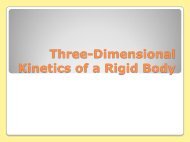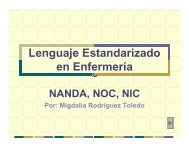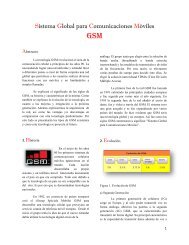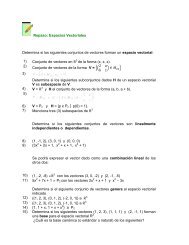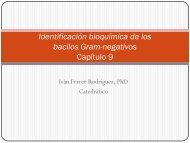Municipal Solid Waste
Municipal Solid Waste
Municipal Solid Waste
Create successful ePaper yourself
Turn your PDF publications into a flip-book with our unique Google optimized e-Paper software.
Disposal of municipal solid waste• The amount of MSW generated in the U.S. isincreasing• More people, changing lifestyles, excessive packaging• In 1960, the average MSW was 2.7 lbs/person/day• In 2007: 4.6 lbs/person/day• In 2007, the U.S. generated enough garbage to fill96,000 garbage trucks/day• We generate huge amounts of MSW and it is harderto dispose of in an environmentally sound and healthyway• MSW varies depending on the generator,neighborhood, and time of year© 2011 Pearson Education, Inc.
Past sins• Until the 1960s MSW was burned and buried indumps• Smoldering dumps smelled and attracted flies and rats• Incineration (combustion facilities): burn wastecompletely• May cause air pollution• Open dumps and incinerators were phased out• Public pressure and air pollution laws• Replaced by landfills• In the last 10 years, landfills and combustion havedeclined• Recycling has increased• Patterns of disposal differ in countries© 2011 Pearson Education, Inc.
U.S. MSW disposal© 2011 Pearson Education, Inc.
Landfills• Landfill: waste is put on or in the ground andcovered with earth• Minimizing air pollution and vermin• But managers did not understand ecology, the watercycle, or products of decomposition• They did not have regulations to guide them• So landfills were put on any cheap land outside oftown• Natural gullies, abandoned quarries, wetlands, olddumps© 2011 Pearson Education, Inc.
Problems of landfills: leachate andgroundwater pollution• Leaching: chemicals dissolve in and are transportedby water• Leachate: water with various pollutants• A ―witches brew‖ of pollutants• Organic matter, heavy metals, chemicals• Can enter groundwater aquifers• All states have, or will have, landfills contaminatinggroundwater• Florida has 145 sites on the Superfund list (siteswhere groundwater contamination threatens humanhealth)© 2011 Pearson Education, Inc.
Problems of landfills: methane• Buried wastes undergo anaerobic decomposition• Producing biogas (methane, CO 2 and hydrogen)• Biogas is highly flammable• Seeping horizontally through soil, it can enter homesand cause explosions• Seeping to the surface, it kills vegetation• Biogas can be captured, purified, and used as fuel• In 2008, commercial landfill gas produced electricityand gas for 1.4 million homes• Reducing greenhouse gas emissions and fossil fueluse© 2011 Pearson Education, Inc.
Westminster landfill© 2011 Pearson Education, Inc.
Problems of landfills: incompletedecomposition• Plastics in MSW resist decomposition• Petroleum-based polymers resist microbial digestion• Biodegradable plastic polymers have beendeveloped• Using cornstarch, cellulose, lactic acid, soybeans• They are more expensive• They are used by organic manufacturing companies• Even biodegradable materials degrade very slowly• Newspapers buried 30 years ago are still readable• Decomposition requires water• But water produces toxic leachates© 2011 Pearson Education, Inc.
Features of a modern landfill© 2011 Pearson Education, Inc.
Siting new landfills• Between 1988 and 2007, landfills decreased from8,000 to 1,754• The EPA does not think capacity is a problem• But people don’t want landfills near them• It is hard to find areas to build new landfills• Any potential site is met with protests and lawsuits• LULU (locally unwanted land use); NIMBY (not in mybackyard); NIMTOO (not in my term of office)• BANANA (build absolutely nothing anywhere nearanything)© 2011 Pearson Education, Inc.
Advantages of combustion• 89 U.S. facilities burn 32 million tons/year of MSW• A waste reduction process, not disposal• Ash must still be disposed of• Combustion reduces weight of trash by 70% andvolume by 90%• Fly ash contains most of the toxic substances• It is landfilled• Bottom ash: is used as fill in construction orroadbeds• Converted to concrete© 2011 Pearson Education, Inc.
Drawbacks of combustion• Air pollution: has decreased through strictregulations• Odor pollution: plants are isolated from residentialareas• Facilities are expensive to build• Siting: facilities are located in industrial areas• Toxic ash must be disposed of in secure landfills• The facility must have a continuous supply of MSW• Agreements with municipalities decreases flexibility inwaste management options• The process wastes energy and materials• Combine burning with recycling and recovery© 2011 Pearson Education, Inc.
The WTE process• Incoming waste is inspected and recyclables areremoved• Shredders reduce waste particles to 6 inches or less• Magnets remove metals for recycling• <strong>Waste</strong> is blown into boilers for burning• Water circulating through the boilers produces steamfor electricity• Metals are separated from bottom ash• Combustion gases are treated to reduce emissions• Fly ash and bottom ash are taken to landfills© 2011 Pearson Education, Inc.
<strong>Waste</strong>-to-energy combustion facility© 2011 Pearson Education, Inc.
Costs of municipal solid-wastedisposal• Costs of disposing of MSW are increasing• Design features of landfills• Expenses in acquiring sites and transportation• Tipping fees average $42/ton (but New York City’s is$263/ton—$1 billion/year!)• One consequence: illegal dumping• Some towns charge $5/bag for MSW, $1/tire, etc.• <strong>Waste</strong>s are appearing in many areas• Buildings put padlocks on dumpsters• Many states track down midnight dumpers© 2011 Pearson Education, Inc.
Better solutions: source reduction• Source reduction: reducing waste at its source• The best solution for domestic wastes• Designing, manufacturing, purchasing, or usingmaterials to reduce the amount/toxicity of trash• U.S. waste has leveled off at 4.5 lbs/person• Due to lifestyle changes• Measured by measuring consumer spending, whichreflects goods and products that become trash• In 2000, 55 million tons did not go into the wastestream© 2011 Pearson Education, Inc.
Examples• Reducing the weight of items• Steel cans are 60% lighter than they used to be• Reducing paper waste via electronic communication,data transfer, the Internet• Reusing durable goods: reselling items• eBay, Craigslist, Freecycle Network• Designing products to last longer and be easier torepair• Staying off of bulk mailing lists• Composting yard wastes© 2011 Pearson Education, Inc.
<strong>Waste</strong> reduction by reuse© 2011 Pearson Education, Inc.
What gets recycled?• Paper (47%): paper, cardboard, insulation, or iscomposted• Glass (28%): new containers, fiberglass or used inhighway construction (glassphalt)• Plastic (12%): carpet, clothes, irrigation drainagetiles, building materials, sheet plastic• Metals: recycling aluminum (39%) saves 90% of theenergy to make cans from ore• Saves energy, creates jobs, reduces the trade deficit• Yard wastes (64%) are composted© 2011 Pearson Education, Inc.
Deck made from Trex© 2011 Pearson Education, Inc.
Other items that are recycled• Textiles (17%): strengthen recycled paper products• Old tires (35%): incorporated into highway asphalt• Over 1 million tires/year are burned in combustionplants• People recycle out of environmental and economicmotivations• The Global Recycling Network is an informationexchange promoting recycling and ecofriendlyproducts© 2011 Pearson Education, Inc.
State recycling rates© 2011 Pearson Education, Inc.
MSW recycling in the U.S.© 2011 Pearson Education, Inc.
Paper recycling• Newspapers: the most important item that isrecycled• 78% of newspaper is recycled• What is meant by ―recycled paper‖?• Recycled paper: routinely recovered and reroutedback into processing• Postconsumer recycled paper is what’s important• It is almost impossible to tell recycled from virginpaper• The market is a critical factor in recycled paper• Is there a demand?© 2011 Pearson Education, Inc.
Plastics recovery• Plastics have a bad reputation• They have a rapid throughput (packaging, diapers,etc.)• The are conspicuous in MSW and litter• They do not decompose in landfills• Bottled water: the number one ―new‖ drink• 8.9 billion gallons were sold in the U.S. in 2007• Only two states with bottle laws include bottled water• People pay 10,000 times more than for tap water• Only 1 in 6 bottles is recycled• But there is a real market demand for plastic© 2011 Pearson Education, Inc.
Materials recovery facility© 2011 Pearson Education, Inc.
Integrated waste management• It is not necessary to use one method of handlingMSW• Source reduction, waste-to-energy, combustion,recycling, MRFs, landfills, composting all have roles• Integrated waste management uses several processes• <strong>Waste</strong> reduction: the U.S. produces the most waste• We are a ―throwaway society‖• True management of MSW begins at home• <strong>Waste</strong>Wise: an EPA-sponsored program that partnerswith local governments, schools, corporations• Partners design their own waste-reduction programs© 2011 Pearson Education, Inc.
PAYT and EPR• PAYT: people pay curbside charges for unsortedMSW• Instead of paying taxes for collection and disposal• Used by 25% of the U.S. population• 25%–45% waste reduction• 32%–59% increase in recycling• The EPA is a facilitator, not regulator• EPR: extended product responsibility• Companies take back used items and manufacturemore durable goods• The EPA provides information© 2011 Pearson Education, Inc.
Closing the recycling loop• Set minimum postconsumer levels of recycledcontent for newsprint and glass containers• Require purchases of certain goods that includerecycled products• Even if they are more expensive• Require that all packaging be reusable or made ofrecycled materials• Tax credits or incentives encourage the use ofrecycled or recyclable materials in manufacturing• Help develop recycling markets© 2011 Pearson Education, Inc.
CHAPTER 22Hazardous Chemicals:Pollution andPrevention© 2011 Pearson Education, Inc.
An introduction to hazardouschemicals• Fish in Lake LeBarge, Canada, have becomehazardous to eat because of high DDT levels• Arctic fish, birds, and mammals have high amountsof persistent organic pollutants (POPs) in theirbodies• DDT, toxaphene, chlordane, PCPs, dioxins• The Inuit people have very high loads of POPs• How do these toxic chemicals reach remote areas?• There are no pesticides or industries© 2011 Pearson Education, Inc.
Chemicals in remote areas• POPs are persistent, bioaccumulate, and biomagnify• They are carried to the Arctic in the air• They condense on the snowpack and enter waterduring the spring thaw• Plankton pick up the chemicals and pass them up thefood chain• Highest amounts are in Arctic ponds near seabirdnests• Feeding birds concentrate the chemicals, which aredeposited to the land and water in guano© 2011 Pearson Education, Inc.
Human exposure to chemicals• Three-fourths of Inuit women have PCB levels 5times above safe levels• Caribou pick up dioxins in lichens and mosses• The Inuit eat the caribou• Some POPs are declining in the Arctic• Others are increasing and accumulating in polarbears, seals, and foxes• E.g., polybrominated diphenyl ethers—PBDEs• Effects include immune-system disorders, hormonedisruptions, cancer, imbalances in births© 2011 Pearson Education, Inc.
Dangers of chemicals• Significant dangers are associated withmanufacture, use, disposal of many chemicals• Few people want to give up their products• The best solution?• Handle and dispose of chemicals in ways thatminimize risks• Over the past 30 years, regulations on chemicalproduction, transport, use, and disposal havemushroomed• The chemical industry is now heavily regulated© 2011 Pearson Education, Inc.
Toxicology and chemical hazards• Toxicology: the study of the harmful effects ofchemicals on human and environmental health• Toxicologists study acute toxicity effects, chroniceffects, and carcinogenic potential• Data on toxic chemicals comes from• The National Toxicology Program (NTC)• The Chemical Repository• The National Institute of Environmental HealthSciences (NIEHS)• The EPA’s Integrated Risk Information System (IRIS)© 2011 Pearson Education, Inc.
Dose response and threshold• The dose (level of exposure multiplied by the lengthof time of exposure) is linked with the response(effects)• If a chemical has a low toxicity, concern centers onchronic or carcinogenic effects• Human exposure to a hazard is a vital part of riskcharacterization• Exposure comes from the workplace, food, water, andenvironment• It is hard to get an accurate determination of exposure© 2011 Pearson Education, Inc.
Threshold level• There is usually a threshold level in the doseresponserelationship• Organisms can usually deal with some level of asubstance without suffering ill effects• Threshold level: the level below which there are no illeffects• Effects above this level depend on concentration andduration of exposure• It is high for short exposures, and lower as timeincreases© 2011 Pearson Education, Inc.
The threshold level© 2011 Pearson Education, Inc.
Threshold levels for carcinogens• The EPA takes a zero-dose, zero-responseapproach for carcinogens• There is no evidence of a threshold level for them• But lower doses are less likely to produce cancers• The field of toxicology is well established• It is the most important source of sound science forsupporting regulations from the EPA and FDA• The NTP was established in 1978• The world’s leader in assessing chemical toxicity andcarcinogenicity© 2011 Pearson Education, Inc.
Chemical hazards: HAZMATS• Hazardous material (HAZMAT): a chemical thatpresents a certain hazard or risk (excludingradioactive materials)• Ignitability: substances that catch fire readily(gasoline)• Corrosivity: substances that corrode tanks andequipment (acids)• Reactivity: chemically unstable substances• May explode or create toxic fumes if mixed with water(explosives, sulfuric acid)• Toxicity: substances that are injurious when eaten orinhaled (chlorine, pesticides, etc.)© 2011 Pearson Education, Inc.
HAZMAT placards© 2011 Pearson Education, Inc.
Total product life cycle© 2011 Pearson Education, Inc.
The threat from toxic chemicals• All toxic chemicals are hazards that threatenhumans• Many are broken down and assimilated• Two classes do not readily break down:• Heavy metals (lead, mercury, arsenic, cadmium, tin,chromium, zinc, and copper) and their compounds• Synthetic organics• If diluted enough in air or water, they may not pose ahazard© 2011 Pearson Education, Inc.
Heavy metals• Are used in industry (metalwork, metal plating),batteries, and electronics• Were once used in paint, glazes, inks, dyes• Lead paint poisoned U.S. children; it was banned in1978• Heavy metals are extremely toxic• They can be soluble in water• If absorbed in the body, they interfere with enzymefunctioning• Small amounts can cause severe consequences• Mental retardation, insanity, birth defects© 2011 Pearson Education, Inc.
Organic compounds• Petroleum-derived and synthetic organics are thebasis for plastics, fibers, synthetic rubber, paintlikecoatings, solvents, pesticides, preservatives, etc.• Resistance to degradation makes them useful anddangerous• Are readily absorbed and interact with enzymes• But they cannot be broken down or processed• Acute effects: poisoning, death• Extended exposure leads to mutagenic, carcinogenic,teratogenic (causing birth defects) effects• Liver and kidney dysfunction, sterility, etc.© 2011 Pearson Education, Inc.
Dirty dozen• Halogenated hydrocarbons: synthetic organics thatcontain halogens: chlorine, bromine, fluorine, iodine• Chlorinated hydrocarbons (organic chlorides): themost common halogenated hydrocarbons• Plastics, pesticides (DDT), solvents (carbontetrachloride), insulation (polychlorinated biphenyls)• Most ―dirty dozen‖ POPs are halogenatedhydrocarbons• All are toxic and cause cancer in animals• Many are endocrine disrupters at low levels• Banned or restricted by the 2004 StockholmConvention© 2011 Pearson Education, Inc.
PERC• Perchloroethylene (PERC): a halogenatedhydrocarbon• Colorless, nonflammable• Used in dry cleaning, as a solvent, in home products• Is carcinogenic to rats and mice• It easily enters groundwater from soil• Human exposure occurs in the workplace and fromusing home products• Dizziness, fatigue, headaches, unconsciousness,cancer• It is listed in NTP’s 2009 Report on Carcinogens as―reasonably anticipated to be a human carcinogen‖© 2011 Pearson Education, Inc.
Landfills• RCRA sets standards for disposal of wastes inlandfills• Concentrated liquids or solids are put into drums• Best-demonstrated available technologies (BDATs)• Treatment standards for wastes are set by the EPA• Reduce chemical toxicity and mobility• Technologies include stabilization and incineration,chemical oxidation, and other specific techniques• Only 23 landfills in North America receive off-sitehazardous wastes• Received 403 million lbs in 2007© 2011 Pearson Education, Inc.
Secure landfills• Secure landfill: a reasonably safe landfill that is lined• It also has a leachate-removal system• It is monitored and properly capped• But the barriers are subject to damage anddeterioration• Surveillance and monitoring systems are needed toprevent leakage© 2011 Pearson Education, Inc.
Secure landfill© 2011 Pearson Education, Inc.
Mismanagement of hazardous waste• Early land disposal was not regulated• Deep wells injected wastes into groundwater• Abandoned quarries were used as landfills• Surface impoundments had no liners• A new enterprise was created: waste disposal• Many reputable businesses were formed• Midnight dumping: disreputable businessespocketed fees, then illegally dumped wastes inabandoned warehouses, vacant lots, or landfills• The individuals responsible could not be found© 2011 Pearson Education, Inc.
Midnight dumping© 2011 Pearson Education, Inc.
Orphan sites• Orphan sites: some companies or individuals storedwastes on their own property, then went out ofbusiness, abandoning the property and wastes• Leaking drums could cause explosions and fires• Valley of the Drums (VOD): in Kentucky• One of the most famous abandoned sites• Love Canal, New York: brought the problem ofunregulated dumping to the public’s attention• The absence of public policy made the situationworse© 2011 Pearson Education, Inc.
Love Canal© 2011 Pearson Education, Inc.
Groundwater remediation• Groundwater remediation: a developing technologyused if toxic materials have contaminatedgroundwater• Techniques involve drilling wells, pumping outcontaminated water, purifying it, and reinjecting it• Cleaning up the source of the water is mandatory• If contamination is severe, remediation may not bepossible• Groundwater is considered unfit for drinking© 2011 Pearson Education, Inc.
LUST remediation© 2011 Pearson Education, Inc.
Superfund for toxic sites• The most monumental task we face is cleaning uptens of thousands of toxic sites• Mangers of operating sites were pressured to cleanup• Many operators simply declared bankruptcy andabandoned their sites• The Comprehensive Environmental Response,Compensation, and Liability Act (CERCLA; 1980)• Known as Superfund• A trust fund that uses money from taxes on chemicalraw materials© 2011 Pearson Education, Inc.
CERCLA• The trust pays for identification of sites, protection andremediation of groundwater, and cleanup of sites• Superfund Amendments and Reauthorization Act(SARA; 1986): greatly expands the Superfundprogram• All sites cannot be cleaned up, so priorities must beset• All sites are identified, and threats to groundwater aredetermined• If no immediate threat exists, nothing else is done• If a threat exists, measures are taken to protect thepublic by isolating the wastes© 2011 Pearson Education, Inc.
National Priorities List• If a site is contaminated and groundwater will reachwells, remediation is begun immediately• National Priorities List (NPL): contains the worstsites• These sites are scheduled for total cleanup• The site is evaluated to determine the most costeffectiveway to clean it up• Efforts are made to identify potential responsibleparties (PRPs)• Industries are ―invited‖ to help pay or participate incleanup activities© 2011 Pearson Education, Inc.
Cleanup technology• Drums of chemical wastes can be picked up andtreated• 4,200 drums were removed from the VOD site• Contaminated soil is run through an incinerator orkiln, which burns off the chemicals• Water is injected into a ring of injection wells anddrawn into a central suction well to cleanse soil• The water is treated and reused for injection• Remediation of the VOD site cost $2.3 million• The site was deleted from the NPL in 1996• The site is undeveloped and groundwater isn’t used© 2011 Pearson Education, Inc.
Mobile incinerator for toxic waste© 2011 Pearson Education, Inc.
Bioremediation• Soil contaminated with toxic organic compoundsdoes not degrade• The soil lacks organisms and/or oxygen• Bioremediation: another cleanup technology• Oxygen and organisms are injected into the site• The organisms feed on and eliminate the pollutants• Then they die© 2011 Pearson Education, Inc.
Plant food?• Phytoremediation: using plants to decontaminateheavy metal-contaminated soil• Plants stabilize the soil and reduce movement ofcontaminants by erosion• They also extract the contaminants by direct uptake• The plants are removed and treated as toxic waste• The process can be slow and is only used wherecontamination is not toxic to plants• Sunflowers capture uranium, poplar trees soak updry-cleaning solvents, ferns thrive on arsenic© 2011 Pearson Education, Inc.
Who pays?• CERCLA is based on the ―polluter pays principle‖• Liability is hard to track down• Users mount legal defenses to disclaim responsibility• If the party can’t be found, or if they can’t pay, theSuperfund trust fund kicks in• Over 70% of cleanup costs have been paid bypolluters• The EPA has gained experience with Superfundsites• Americans still rate toxic waste third in environmentalconcerns© 2011 Pearson Education, Inc.
Worker protection: OSHA• Industries used to force workers to do jobs thatexposed them to hazardous materials withoutinforming them of the dangers involved• Occupational Safety and Health Act of 1970• Its amendments make up the hazard communicationstandard (worker’s right to know)• Worker’s right to know: businesses, industries, andlabs must make information on hazardous materialsavailable• Along with providing suitable protective equipment© 2011 Pearson Education, Inc.
MSDS• Material safety data sheets (MSDSs): giveinformation on over 600 chemicals when they areshipped, stored, and handled• Contain information on reactivity and toxicity• Tell what precautions to follow when using thechemical• It is the worker’s responsibility to read theinformation and exercise precautions© 2011 Pearson Education, Inc.
SARA• Superfund Amendments and Reauthorization Act of1986 (SARA)• The Emergency Planning and Community Right-to-Know Act (EPCRA): Title III of SARA• EPCRA: companies handling over 5 tons of anyhazardous material must account for storage sites,feed hoppers, etc.• A local emergency planning committee gets theinformation• Gives it to fire and police departments, hospitals, etc.© 2011 Pearson Education, Inc.
The Toxic Substances Control Act• In the past, substances were introduced withouttesting for side effects• The Toxic Substances Control Act (TSCA; 1976):before a chemical can be bulk produced,manufacturers must submit a ―pre-manufacturingnotice‖ to the EPA• It details potential environmental and health risks• The EPA may restrict or prohibit the product• The EPA must use the ―least burdensome‖ approach• Compare the costs and benefits of regulation© 2011 Pearson Education, Inc.
Major hazardous-waste laws© 2011 Pearson Education, Inc.
Environmental justice defined• It is the fair treatment and involvement of all people• Equal enforcement of environmental laws,regulations, and policies regardless of race, color, etc.• No group of people should bear a disproportionateshare of negative environmental consequences• Hazardous facilities are more likely to be located inareas where most residents are non-Caucasian andpoor• The rich generate wastes but don’t want them close© 2011 Pearson Education, Inc.
Federal response• President Clinton issued an executive order in 1994focusing agency attention on environmental justice(EJ)• The EPA’s EJ program has awarded millions toorganizations and local governments addressing EJissues• International EJ: some developing countries importhazardous wastes from developed countries formoney• The Basel Convention: an international agreementbanning most international toxic-waste trade• The Basel Action Network publicizes and coordinateslegal challenges to waste shipments© 2011 Pearson Education, Inc.
Pollution prevention• Pollution control: uses technology to preventpollutants from entering the environment• ―End of the pipe‖ solutions• Pollutants still need to be disposed of• Involves regulations and control• Pollution prevention: involves changing production,materials, or both so pollutants won’t be released atall• For example, using a catalytic converter vs.redesigning an engine• Better products with less waste© 2011 Pearson Education, Inc.
Green chemistry• Substitution: another way to avoid pollution• Finding non-hazardous substitutes for hazardoussubstances• Wet cleaning: water-based cleaning compoundsinstead of dry-cleaning chemicals• Products can be biodegradable• Reuse: cleaning up and recycling chemicals• Prevention, substitution, and reuse have reducedhazardous-waste releases• Public disclosure of TRI data plays a crucial role© 2011 Pearson Education, Inc.
You, the consumer• Pollution avoidance can be applied to the individual• Reducing or avoiding products containing harmfulchemical• Also reducing chemical by-products• The average American home contains 100 lbs ofhousehold hazardous waste (HHW)• Paints, stains, pesticides, motor oil, etc.• They must be safely stored, used responsibly, anddisposed of properly© 2011 Pearson Education, Inc.
Green products• Products that are more benign than their traditionalcounterparts• How fast and to what degree will these productsreplace traditional products?• It depends on how we behave as consumers• Buying power can be an extremely potent force• In conclusion, there are four ways to addresschemical pollution• Prevention, recycling, treatment, safe disposal• The first free promote a minimum of waste© 2011 Pearson Education, Inc.


